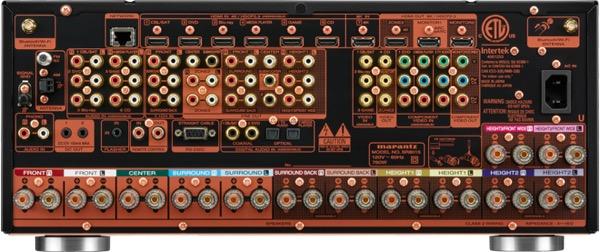Making a Choice: AVRs vs. Separate Components

But before you consider any of these things you’ll need to decide between a A/V receiver (AVR) or a preamp-processor (pre-pro), the latter also often called a surround-sound processor. At the risk of boring experienced readers, and without going too deeply into the weeds for newbies, a pre-pro separates the control unit (which provides the first stages of amplification and digital conversions, and which the user interacts with to make changes to the desired input, volume, surround mode, and more) from the actual amplifier or amplifiers that drive the speakers. Separate amps can offer more choices, a wide range of power, and flexibility of placement, sometimes even locating them at some distance from the pre-pro. For those reasons, and others, separates are the frequent choice of custom installers, but many enthusiasts employ them as well. The AVR puts all of this into a single chassis.
Separating the electronics into two or more chassis is a concept that was first seen on home audio gear before home video was a thing. Back in audio’s paleolithic age, Cro-Magnon audiophiles noticed that their amps were overheating and sometimes failing. So to minimize that, and also keep the cave cooler, manufacturers split them into two pieces. The idea caught on, and it stuck even when transistors minimized the heat (and also reduced the number of hamsters needed to power it all up). But two chassis were more expensive than one, and this gave rise to the audio receiver, which was far less pricey than separates. When video entered the game, the AV receiver was the obvious next step. But the separate pre-pro and amplifier had its loyal adherents, and still does. So which should you choose?
If budget is an issue, as it is for most of us, the choice is usually the AVR. Available in a wide range of prices and features, it dominates the home theater market. Once you’ve decided to go this route, you need to be realistic in what you’ll need in your system, now or later. If it’s currently 5.1, do you plan on going to 7.1, and/or adding Atmos now or later. Be sure to add up the number of channels you need for any of these options, remembering that the upgrade bug is always in waiting even if you don’t plan to ever go beyond your current plans. If you settle for 5.1 now and in two years decide to go further, you might need to dump the 5.1 AVR you bought today in order to achieve your new goal.
That might well involve more channels. Fortunately, many AVR makers now offer models that can process more channels than their on-board amps can support. They’ll have preamp outputs for these additional channels, most often two more, with you supplying outboard amps they’ll need. But often the channels assigned to the on-board amps are locked into specific channels. In such an AVR with seven onboard amp channels those are typically L,R,C, Left and Right side surrounds and Left and Right rear surrounds. You can’t decide to go with only side surrounds and reassign those rear surround channels to Atmos use. That means that you can only have two Atmos channels from such an AVR, driven by the two extra preamp outputs connected to external amps, even if you don’t use the sixth and seventh built-in amps for rear surrounds. There are AVRs that allow you to reassign at least some of those internally amplified channels to another use, but you might need to do some research to determine if the AVR you have your eye on is one of them. This isn’t always clear from the promotional material.
You’ll also need to be sure that the AVR you choose has all of the features you need now or plan on using later. All of them now offer video switching (some for as much as 8K, though 4K is most common). They might offer video upconversion and even video controls, but the latter are superfluous and best left to the controls on the display. Gamers might want HDMI 2.1, but the availability of this feature is, for now, sketchy at best. And It’s not really needed for current consumer sources (though it might be useful in a year or three).
So what about those separatesa pre-pro with outboard amplifiers? While typically pricier than the AVR, this route can offer advantages. It’s often used in custom installations where the amps don’t even have to be in the same room as the rest of the system. Because of this, a pre-pro usually offers both RCA and balanced connections to the amps. AVRs generally don’t offer balanced connections, but with the preamp and amps on the same chassis they don’t need them. Some will argue that balanced connections offer better sound, but there’s no real evidence for that apart from their resistance to noise pickup in long runs to the amplifiers. In decades using unbalanced cables (of 25-feet or less), I’ve never experienced audible noise in a pre-pro to power amp hookup. What balanced definitely does offer are better and more secure connections than the ubiquitous and less durable RCA plugs, and often less crowded connections on the back of the pre-pro as well. These can be important to those who change gear frequently (i.e., reviewers!).
The pre-pro route rarely offers more features than a good AVR, apart from sometimes offering channels in numbers rarely used in a home system (at prices to match). And while some will argue that separates offer better sound than an AVR, that argument remains in the never-ending battle between the “everything makes a difference” perfectionist audiophiles and the equally insistent “all amps (used within their design limits) sound the same” brigade. In my experience a good, well designed AVR can make a very good case for itself and satisfy most buyers. But separates do offer more flexibility, plus the opportunity to move on to a new pre-pro without having to junk or sell a perfectly good AVR to achieve the same upgrade. While there have been intriguing new developments in amplifier design (particularly in the class-D realm), a good amplifier will last longer without risk of obsolescence (sometimes for decades), than any pre-pro or AVR.
But if you’re in the market in either camp, I highly recommend that you thoroughly research the products on your short list. While hands-on experience is important, AVRs and pre-pros typically upload the owner manuals for their products on their websites, and anyone can download and review them to learn more about each product than most salesmen ever knew. But allow plenty of time; AVR manuals can now run into hundreds of pages!





























































